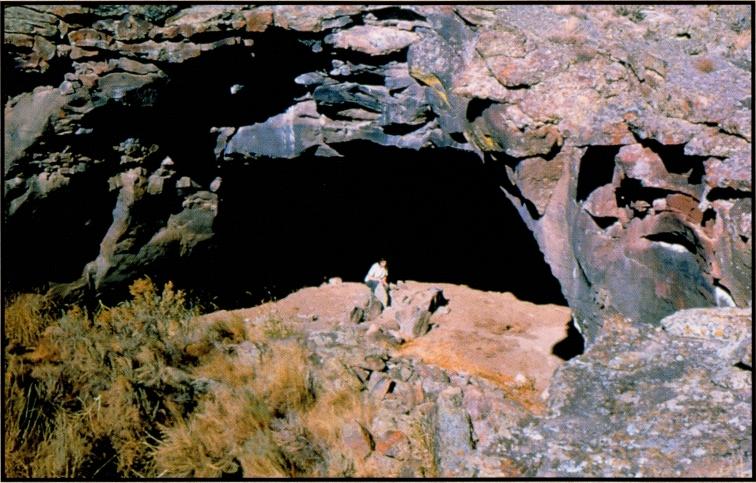By Ruthann Knudson, Ph.D., RPA, and Susanne J. Miller

Not all important Folsom sites have beautiful tool collections—some are pretty small and beat up! But they are no less significant—for example, the Folsom collection from the Wasden Owl Cave site (Fig. 1).

Figure 2.
The eastern Idaho Snake River Plain is a 60-mile-wide, 125-mile-long high altitude landscape of plains, seasonal and dry lake beds, marshes, sinks, sand dunes, lava blisters, and obsidian-bearing mountains. The Snake River lies on its eastern side and mountains bound it to the east and west. It ends in the north in a grassy continental divide that itself leads to the basin-and-range valleys of the northwestern High Plains. In its center, set into a sagebrush prairie steppe, is a three-cave complex of collapsed lava blisters known as the Wasden site—including Owl Cave.
The privately owned Wasden site was found by Helen and Richard Gildersleeve of the avocational Upper Snake River Prehistoric Society, Inc. (USRPS) in the mid-1960s. Society members were involved in excavations at the site for over a decade—and still are involved today.
Owl Cave (10BV30) was first excavated by Idaho State University archaeologist B. Robert Butler in 1965-1971 (Butler 1978). Butler excavated down through a dense bison bone bed that has been dated between 7800 and 8200 years ago, and which was underlain by a layer of heavy rockfall. There was a suite of points of a generalized Late Plano style (Butler 1978: Fig. 34) associated with the bone bed. These are similar to materials from the Birch Creek sites in Idaho (Swanson 1972), the Barton Gulch (Davis et al. 1989) and Myers-Hindman (Lahren 2006:104-131) sites in Montana, and the Mummy Cave (Rusted and Edgar 2002), James Allen (Knudson and Kornfeld in press), and Hell Gap (Larson, Kornfeld, and Frison in press) sites in Wyoming. Below the bison bed and its underlying rockfall is a Folsom level.
From 1974 through 1977 ISU doctoral student Susanne J. Miller and the USRPS excavated below the rockfall into a deposit of butchered mammoth and other bones and associated Folsom tools, working with a variety of specialists and the support of the National Science Foundation. The extinct fauna and fluted points were found in distinctive, wet, dark silt. Associated with the mammoth bones and Folsom tools were the remains of Bison antiquus, camel, pronghorn antelope, dire wolf, badger, fox, and many microfaunal species. The level probably extends farther back into the lava tube as well as out in front of the cave under the rock debris of the collapse depression. Mammoth bone collagen from the Folsom deposits was radiocarbon dated at 10,920±150 years ago (WSU-1786; Miller 1982:89).
The mammoth bone was heavily butchered, and apparently a sophisticated bone technology had been used on and with the remains (Miller 1989). There is evidence of percussion fracturing of the bone, marrow extraction, and the collection includes two bone cores and a bone flaker.

Figure 3. Figure 4.
The Folsom assemblage includes three obsidian point fragments, a chalcedonic chert point fragment, one chert microtool, a chert or silicified wood bifacial cutting/scraping tool, a bone flaker, and a dozen pieces of flaking debris – all well used.
Finally, the collection includes a chert microtool that we pulled out of the dozen or so flakes found in the excavations (Fig. 7a-c). This tiny piece (the worked and working edge is only 7mm long) must have been inset into a fine haft and used like a pen knife. We are not sure of the source of this chert. We have not seen anything like this before, but comparable tools are easily overlooked in the small flake collections from other sites.

The Folsom folks butchering out animals at the Wasden Owl Cave site certainly did not leave a lot of stone tool evidence behind them, and the pieces they did leave were heavily used. I suspect that the chalcedonic chert point tip, flaked cutting/scraping tool, and microtool were originally lost in the gore, but the three obsidian pieces appear to have been so broken and/or used that they were just discarded. This pattern is comparable to the Folsom materials from the MacHaffie site in Montana (Forbis and Sperry 1952), which is some 250 miles north of Wasden Owl Cave over that low prairie continental divide. While quite a few Folsom or Clovis fluted points have been found on the surface of Idaho’s Snake River Plain (Titmus and Woods 1992), the Wasden Owl Cave is a rare tale of a Folsom living/working surface this far northwest in North America.